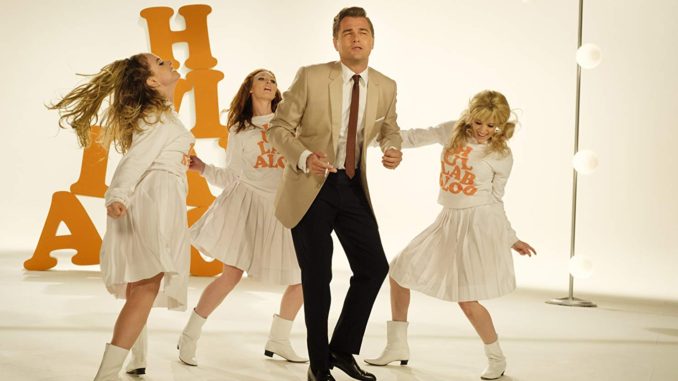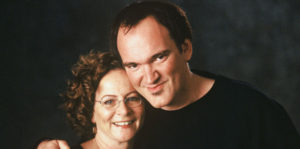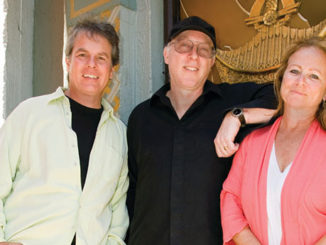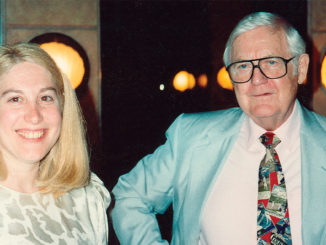
by Patrick Z. McGavin
Once Upon a Time … in Hollywood marks the third collaboration between director Quentin Tarantino and editor Fred Raskin, ACE.
Set against the tumultuous backdrop of 1969, the new movie intertwines the stories of the fading Western actor Rick Dalton (Leonardo DiCaprio), his stunt double Cliff Booth (Brad Pitt) and the efflorescent young actress Sharon Tate (Margot Robbie), all played out against the encroaching madness represented by the notorious Manson Family murders.
Managing the strands of that complicated narrative fell to Philadelphia native Raskin, who has emerged as one of the best-known editors of his generation.
A graduate of New York University film school, Raskin has been a member of the Guild since 1996. After working as an assistant for artistic heavyweights like Paul Thomas Anderson and Christopher Nolan, Raskin began his apprenticeship with Quentin Tarantino on Kill Bill: Vol. 1 (2003) and Kill Bill: Vol. 2
(2004), under the tutelage of the late Sally Menke.
In this exclusive interview, Raskin talks about his creative collaboration with Tarantino, working from 35mm film in a digital world, the new film’s ambitious period reconstruction and the art of cutting music, image and sound. (Warning: Some mild spoilers follow.)
CineMontage: How would you characterize your creative collaboration with Quentin Tarantino?
Fred Raskin: On the Kill Bill movies, my creative work was primarily cutting sound effects for the great Sally Menke, Quentin’s brilliant editor.
More significantly in terms of my relationship with Quentin, whenever Sally and Quentin would finish a scene, they would bring everybody into the room, play the scene and get our reactions. It was immediately clear that the more vocal we were, the better. Quentin has told me that my willingness to provide feedback was a key
factor in his choosing me to cut Django Unchained (2012).

I began my editing career immediately after Kill Bill, cutting Annapolis (2006) for Justin Lin. Over the years I’d run into Quentin, usually at random screenings at the [revival house] New Beverly Cinema — this was before he owned the theater — and we’d always stop and chat about whatever movies we’d seen recently. I think he saw a kindred spirit in me. So he kept me in the family, inviting me to rough-cut screenings of both Death Proof (2007) and Inglourious Basterds (2009), which was a tremendous honor.
Is he in the editing room a lot with you?
Raskin: During production, Quentin does not enter the editing room. He doesn’t want to look at any edited footage while he is in production because he just wants to focus on shooting the movie. The only exception to that is if I’m cutting something that needs to appear as playback material later in the shoot — like, for example, the scene from The FBI that Rick and Cliff watch together.
When production ends, he’s coming in every day, and spending the whole day sitting beside me at the Avid. But during production, he basically says, “Just do your thing,” and I am working with pretty much complete freedom, outside of the fact that he generally does not want me to cut with music. He has certain ideas in his
head about how the music is going to fall over the picture, and he does not want to watch a scene in which I’ve placed the music in a way that is different from how he imagined it. As our relationship has developed, I have occasionally broken that rule, usually when I feel I have a particularly solid grasp on Quentin’s intentions.
Tarantino is obviously a film purist. The Hateful Eight was shot in 70mm, and the new film is in 35mm. Did you edit in analog as well? What were the particular challenges of the format?
Raskin: The negative was developed and printed so that we could screen dailies on 35mm. It was also scanned at 4K. Those 4K scans were down-converted to Avid DNX 115 HD files. That’s what I’d edit with in the Avid. Once production ended Quentin would spend his whole workday in the cutting room with me. When we completed a scene, my Avid assistant would take the cut from me and would generate lists that would go to the film team, who would then conform the film print to match the Avid edit. In that way, we were able to screen the scenes projected on film. Just seeing it that way added to the authenticity of the material.
Like most of Tarantino’s films, there is a lot of interpolated material, including detailed recreations of Fifties black-and-white Westerns, Sixties exploitation films and Italian spaghetti westerns. What is the most difficult part of integrating that into the larger syntax of the film?
Raskin: To be honest with you, that was the most fun part. The movie really does have a little bit of everything, and I got to work in every genre out there. I guess making it feel authentic was a bit of a challenge, but the truth is, Quentin knew what he was doing when he shot those scenes.
We did a lot of work with our post sound team, led by Wylie Stateman (MPSE) and Mike Minkler (CAS), to make it sound authentic. For example, in the Bounty Law material — that’s the late-fifties Western that we see some clips of early on in the movie — they gave the sound quality of a 16mm print, adding a little warble to the dialogue. It’s a subtle thing, but it goes a long way toward establishing the authenticity of the material.
Leonardo DiCaprio’s character Rick Dalton is an actor confronting his own obsolescence. The Lancer scene in the trailer, where you accelerate the rhythm through jump cuts, was that something you and Quentin developed intuitively?
Raskin: That scene was not in the screenplay, it was something that Quentin came up with in the course of shooting the movie. Rick is questioning whether or not he’s a good enough actor to work in this industry and he’s having a freak-out.
This was one of the rare instances where Quentin did not write out all of the dialogue. He came up with an outline of particular beats that he wanted Leo to hit, and he had him improvise the scene. They shot it all from one angle, and I think they did four takes. Leo is just brilliant in the scene, infusing physical comedy into his character’s self-loathing. He really nailed it.
We had these four takes, and then it was about going through and finding our favorite bits. It was obvious when I saw the dailies we’d have to use the jump cuts, because there was only one angle and the scene plays on for up to five minutes. The jump cuts give us a sense of Rick’s mental state, his frustration and how mad
he was at himself.
Tarantino packs so much into the frame, bric a brac, the signage, the Mad magazine illustrations, the references to other movies. That must be a daunting challenge given the saturation.

Raskin: When Quentin shoots those inserts that are setting up Cliff’s trailer or Rick’s house, and you see all the stuff on the walls and the shelves, you know that he intends to have these inserts play a part in establishing the characters. So it became a question of how much we could fit. We narrowed down what the key ones were that he wanted to have in there. The trick was to make space for them without extending the length of the scene.
There are certain motifs and cutting patterns that you play off, for instance the number of very important scenes that take place in the interior of cars. How did you go about creating a different dramatic rhythm to differentiate those scenes?
Raskin: As with everything Quentin shoots, the footage dictates how it is going to be cut. When Rick and Cliff are driving home and Rick is talking about being at the end of his career, there was truly only one angle to work with, so the rhythm there was dictated by the performances.
The scene in which Cliff and Pussycat (Margaret Qualley) are driving on the freeway was covered in a number of different angles. But honestly, I don’t think there is anything about the driving scenes that differentiates them stylistically from anything else in the movie. This is the way Quentin wants to tell the story. From
watching the dailies you get a pretty good sense of how he intends for the scene to go together.
The Spahn Ranch scene is the most important of the film. There is a lot to unpack, the sexual undercurrent between the characters of Cliff and Pussycat that becomes much more menacing and marked by suspicion and a sense of mounting dread. Was that the most challenging scene?
Raskin: I read the Spahn Ranch sequence in the script and I thought it was terrific, but it wasn’t until the dailies started coming in that I really had a sense of what Quentin was doing. I remember after watching the first day of dailies, I told him, ‘Ah, so now we’ve just entered into The Texas Chain Saw Massacre.’
It’s similar to what Quentin did with Kill Bill, telling the story by jumping from genre to genre. Once this sequence begins, we’re in a horror movie. You have the Manson Family [members] peering out from doorways and windows and you just have this sense of dread as to what horrible things are going to happen to Cliff.
When I told Quentin, after watching the dailies, that I didn’t realize we were making The Texas Chain Saw Massacre, he could not have been happier. We really leaned into that idea when it came to the sound effects. One of our sound editors, Leo Marcil, was working with us, and he cut lots of low tones and creaking metal and wood for the sequence. Even though I wasn’t cutting with music, the sound effects really worked in conjunction with the photography to create the atmosphere of suspense.
Music is also important to the rhythm and shape of each sequence. How did you incorporate the music into the post?
Raskin: I probably knew maybe a fifth of the songs that Quentin was intending to use, and in most of those instances it was because he’d be playing them on set as he was shooting a scene. Quentin said to me, “I try not to tell you what songs I’m going to use, because in general, I want to see it dry for the first time.”
A lot of times Quentin has got stuff in his head that he doesn’t share with me until he comes in post. In the sequence with Roman [Polanski] and Sharon driving to the Playboy Mansion, there are a number of jump cuts that came about once we laid in Deep Purple’s “Hush” over that drive. The combination of the music and the images, with Sharon running her hands through her hair in slo-mo, or Roman’s car jump-cutting down the long driveway of the mansion, helped establish the atmosphere of the period.
The movie is a fantasia, the mixing of the real and the imagined. We see that where Rick imagines a counter existence where he played the Steve McQueen role in The Great Escape. When Margot Robbie, who plays Sharon Tate, goes to watch herself in The Wrecking Crew, it’s the real Sharon Tate that we see, right?
Raskin: That is correct. I believe that was always Quentin’s plan. I think it works beautifully, and it makes the film an even stronger tribute to Sharon. I think part of the intention in making the movie was to take a person who is known primarily for the way she died, and to turn her into a real living, breathing human
being. I think the sequence of Sharon going to see herself in The Wrecking Crew really grounds her and allows the audience to see her as a real person.
How long was your first cut?
Raskin: My assembly of this movie was enormous. It was over four and a half hours long. We had to cut an entire feature out of this movie. Figuring out how we were going to do that was one of the big challenges.
Originally there were four Lancer scenes — in the final film, there are only two — and as originally conceived, the audience would actually be able to follow the story of the Lancer episode. It added one more layer of entertainment value to the movie. Quentin said before we started shooting that he was considering the
Lancer material to be his third Western. He was not going to be directing it like a typical TV Western. He was going to be directing it like a Quentin Tarantino Western.
‘I consider myself a director’s editor. I want to get the director’s vision up on the screen.’
There was a day in which we were in the editing room with my crew, and we’d watched the whole movie from beginning to end. And when it ended, Quentin just said, “I can’t believe I’m saying this, but I think we’re going to drop the fourth Lancer scene.” That was really the big [eureka] moment of how we were going to get the
movie down to a reasonable length, because once the end of the Lancer episode went away, we were able to lose the beginning as well. Lancer became about Rick’s struggle to give a good performance. It became clear that the movie’s focus needed to be on Rick, Cliff and Sharon. Anything not central to them was not going to be essential.
How would you describe your own philosophy about editing?
Fred Raskin: I subscribe to the Michael Kahn theory: I cut with my gut. It helps when you have a director with a strong vision. Just by looking at the footage you can get a good sense as to how it is intended to be put together. Then you feel it out. The scene in which Sharon watches herself in the fight scene in The Wrecking Crew, where we’re cutting between Margot sitting in the theater, Sharon on screen in the movie, and a flashback to her training for the fight is a perfect example of a time when I just had to work my way through it and figure it out. What was going to be the most effective way to make it clear what’s happening in the scene?
I think what is most impressive about your work is that you have also made some very effects-intensive films, like the Fast and the Furious films with Justin Lin and the Guardians of the Galaxy films with James Gunn, and yet like Tarantino’s work, they are all very author-shaped works and very much reflect the sensibility of the director.
Raskin: I consider myself a director’s editor. I want to get the director’s vision up on the screen. That is not to say there won’t be disagreements or discussions about the best way to play something. I would never try to do something that is in opposition to the director’s wishes. And in all of those examples, we’re talking about writer-directors, so I want to be respectful that these projects originated from their heads.
As a result, when you’re talking about a filmmaker who came up with the concept, who had the idea, put it down on paper, directed it and is now in the last stage of authorship, the editing room, you have to be respectful of all the work they have put into that. You want to feel that in the last stage of making their movie,
you are helping them to realize what they originally intended when they sat down with their pad and pen or computer all those months ago.
Patrick Z. McGavin is a Chicago-based film critic and cultural journalist. His writing on film is frequently published at RogerEbert.com and the Chicago Reader.
RELATED STORIES:





